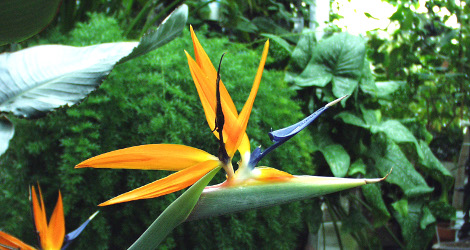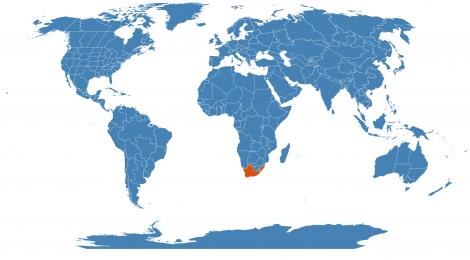Accession Data:
Strelitzia reginae Banks
- Common Name: Bird of Paradise, Crane Lily
- Family: Strelitziaceae (Schumann) Hutch.
- Description: To 3 feet, trunkless, clump-forming; leaves oblong-lanceolate, to 1.5 feet long, six inches wide, acute, glaucescent beneath, the blade sometimes reduced; bracts green, edged with purple or red, to 8 inches long; flowers orange or yellow with dark blue tongue. The hard, beak-like sheath from which the flower emerges is termed the spathe. This is placed perpendicular to the stem, which gives it the appearance of a bird's head and beak; it makes a durable perch for holding the sunbirds which pollinate the flowers. The flowers, which emerge one at a time from the spathe, consist of three brilliant orange sepals and three purplish-blue petals. Two of the blue petals are joined together to form an arrow-like nectary. When the sunbirds sit to drink the nectar, the petals open to cover their feet in pollen.2
- Uses: Commonly used as a cut flower in the florist trade.
- Culture: Can be grown as a houseplant in a tub with a minimum night temperature of 50F. Propagated by suckers, division and seeds.
- USDA Zone: 9b-11
Accession Data:
- Accession # 198500292
- Source: Unknown
- Recorded Vouchers:
- Voucher CONN00057512 at George Safford Torrey Herbarium (CONN). Specimen collected 20 January 1969. Herbarium Image
- Accession Date: 12-31-1985
- Bench: 1118 - AFR:Ground Bed 2 SW
- Currently: active - healthy
- Qty: 1 confirmed on 02-26-2025
Classification:
- Division: Magnoliophyta
- Class: Liliopsida
- SubClass: commelinids
- Order: Zingiberales
- SubOrder:
- Family: Strelitziaceae
- SubFamily:
- Tribe:
- SubTribe:
Flowering Data:
This accession has been observed in bloom on:| Year | Jan | Feb | Mar | Apr | May | Jun | Jul | Aug | Sep | Oct | Nov | Dec | ||||||||||||||||||||||||||||||||||||||||
|---|---|---|---|---|---|---|---|---|---|---|---|---|---|---|---|---|---|---|---|---|---|---|---|---|---|---|---|---|---|---|---|---|---|---|---|---|---|---|---|---|---|---|---|---|---|---|---|---|---|---|---|---|
| 2025 | ||||||||||||||||||||||||||||||||||||||||||||||||||||
| 2024 | ||||||||||||||||||||||||||||||||||||||||||||||||||||
| 2023 | ||||||||||||||||||||||||||||||||||||||||||||||||||||
| 2022 | ||||||||||||||||||||||||||||||||||||||||||||||||||||
| 2021 | ||||||||||||||||||||||||||||||||||||||||||||||||||||
| 2020 | ||||||||||||||||||||||||||||||||||||||||||||||||||||
| 2019 | ||||||||||||||||||||||||||||||||||||||||||||||||||||
| 2018 | ||||||||||||||||||||||||||||||||||||||||||||||||||||
| 2017 | ||||||||||||||||||||||||||||||||||||||||||||||||||||
| 2016 | ||||||||||||||||||||||||||||||||||||||||||||||||||||
| 2015 | ||||||||||||||||||||||||||||||||||||||||||||||||||||
| 2014 | ||||||||||||||||||||||||||||||||||||||||||||||||||||
| 2013 | ||||||||||||||||||||||||||||||||||||||||||||||||||||
| 2012 | ||||||||||||||||||||||||||||||||||||||||||||||||||||
| 2011 | ||||||||||||||||||||||||||||||||||||||||||||||||||||
| 2010 | ||||||||||||||||||||||||||||||||||||||||||||||||||||
| 2009 | ||||||||||||||||||||||||||||||||||||||||||||||||||||
| 2008 | ||||||||||||||||||||||||||||||||||||||||||||||||||||
| 2007 | ||||||||||||||||||||||||||||||||||||||||||||||||||||
| 2006 | ||||||||||||||||||||||||||||||||||||||||||||||||||||
| 2005 | ||||||||||||||||||||||||||||||||||||||||||||||||||||
| 2004 | ||||||||||||||||||||||||||||||||||||||||||||||||||||
| 2003 | ||||||||||||||||||||||||||||||||||||||||||||||||||||
References (internal):
- Bird Pollination (ornithophily)
- Pollination Syndrome Scavenger Hunt
- EEB 3271 - Systematic Botany
- Floriculture CDE Plant List
- Plants with Vouchers deposited in CONN
- EEB Greenhouse Holdings native to: Cape Provinces / KwaZulu-Natal /
References (external):
- Hortus Third, LH Bailey Hortorium, 1976
- Wikipedia. Accessed 2 April 2015.
- The Plant List (2013). Version 1.1. Accessed 2 April 2105.
- WCSP (2015). World Checklist of Selected Plant Families. Facilitated by the Royal Botanic Gardens, Kew. Accessed 2 April 2015.
data regenerated on Sat, 29 Mar 2025 11:09:03 -0400 [bcm v4.0]
Images:

Additional images for this accession:
Click on thumbnails to enlargeCurrent Accessions in the Strelitziaceae
W/C = Wild Collected = indicates flowering in past 14 days
= indicates flowering in past 14 days
 = images available for this accession
= images available for this accession
 = map available for this accession
= map available for this accession
 = accession added within past 90 days
= accession added within past 90 days


